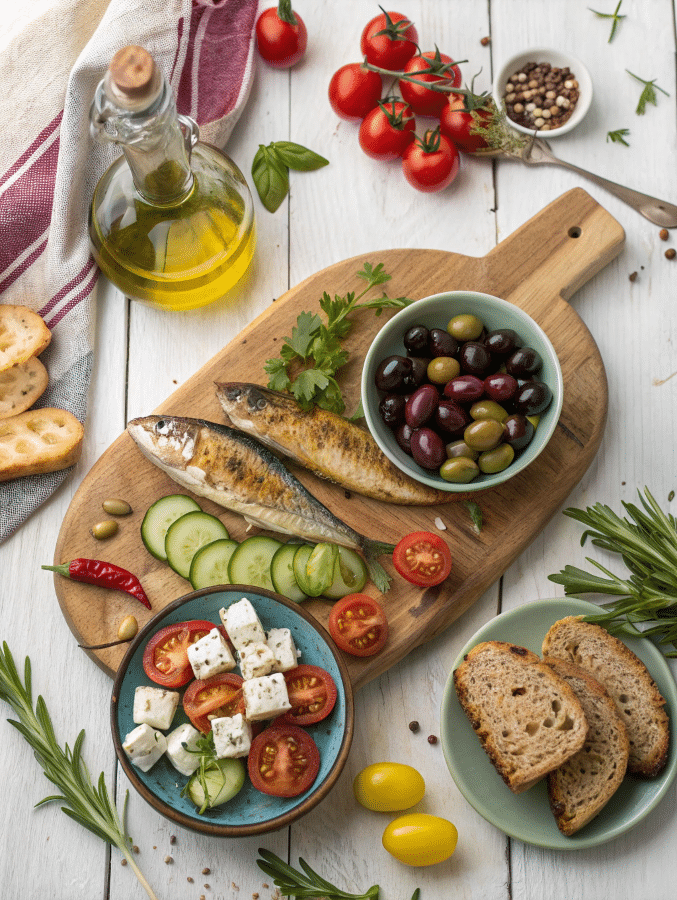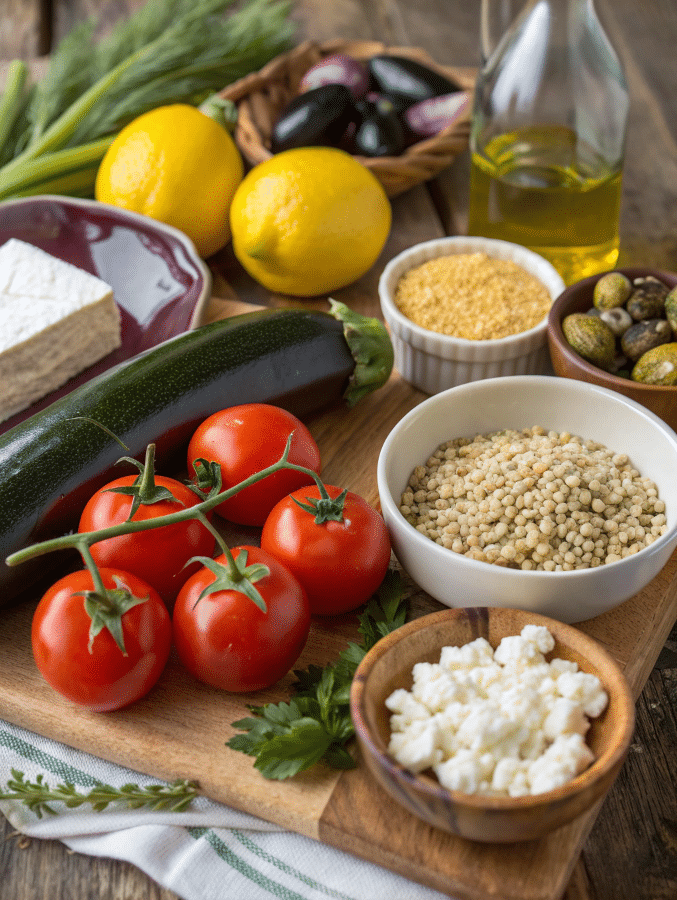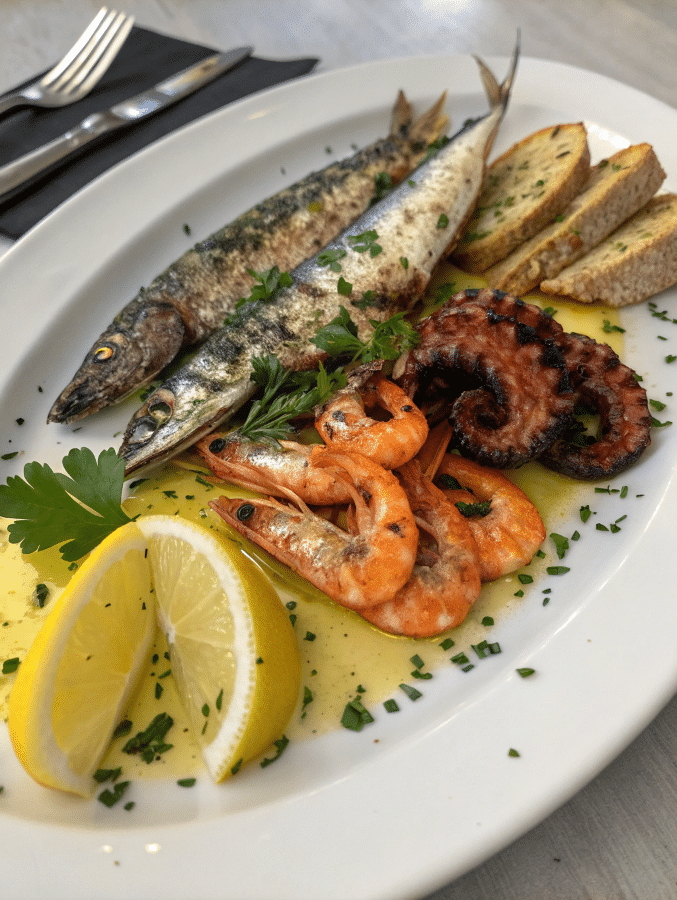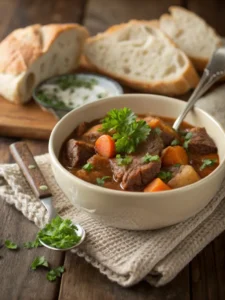
Mediterranean diet food list essentials are more than a checklist, they’re the foundation of a lifestyle that fuels your body and uplifts your meals. Rooted in the sun-soaked traditions of coastal Greece, Italy, and Spain, this diet highlights whole, vibrant foods that support long-term health and well-being.
This guide breaks down the complete Mediterranean diet food list into easy categories: vegetables, fruits, proteins, grains, healthy fats, and pantry staples. You’ll learn how to stock your kitchen, prep balanced meals, and make smart choices that don’t feel restrictive. Whether you’re just beginning or refining your routine, this list will help you eat better, feel better, and cook with purpose.
Let’s begin with the story of how this all started, right from my home kitchen in Austin.
In this Article
Key Takeaways: What You Need to Know
- The mediterranean diet food list focuses on whole, nutrient-rich foods like vegetables, fruits, legumes, whole grains, olive oil, nuts, and seafood.
- Red meat and processed foods are limited, while seafood, eggs, and poultry appear in moderation.
- Olive oil is the primary fat source, making it a cornerstone of the mediterranean diet food list.
- Following this list supports heart health, weight management, gut health, and cognitive function.
- The mediterranean diet food list is flexible, affordable, and adaptable to any kitchen — making it one of the most sustainable diets worldwide.
How I Fell in Love with the Mediterranean Way of Eating
Hi, I’m Olivia, welcome to WeTasteRecipes! Living in sunny Austin, Texas, I grew up surrounded by flavors from all over the world, but nothing grounded me quite like the Mediterranean approach to food. It all started one summer when I stumbled upon an old Greek cookbook at a local thrift shop. I didn’t know it then, but flipping through those worn pages marked the beginning of my journey into the world of vibrant vegetables, clean proteins, and olive oil as liquid gold.
Back then, my idea of healthy eating was mostly salads and smoothies. But this cookbook showed me that a real Mediterranean diet food list includes comfort foods too, like lentils slow-cooked with tomatoes or roasted eggplant drizzled with tahini. I began experimenting at home, starting with one simple Mediterranean meal plan and expanding from there.
What I loved most? The simplicity. The freshness. And the way meals centered around connection. I wasn’t just changing what I ate, I was reconnecting with why I cook at all.
Why This Food List Isn’t Just a Trend – It’s a Lifestyle
The mediterranean diet food list isn’t some fleeting trend; it’s a timeless, research-supported blueprint for health. According to the U.S. Department of Health & Human Services, this eating pattern is associated with better heart health, weight management, and reduced inflammation. At the heart of it all? Balanced meals made up of real, minimally processed foods.
It’s not about perfection, either. The beauty of this diet is in how flexible and forgiving it is. You don’t need specialty ingredients or chef-level skills. You just need to know the core foods, and that’s exactly what the Mediterranean diet food list delivers. Think whole grains, legumes, leafy greens, olive oil, and fresh seafood, which are all detailed in our beginner’s Mediterranean diet guide.
This way of eating celebrates what’s local, seasonal, and good for the planet too. As you’ll see in the sections ahead, you can use this list to guide every grocery run, weekly menu, and meal you prepare. Ready to stock your kitchen the Mediterranean way?
Vegetables, Fruits, and Greens in the Mediterranean Diet

Leafy Greens, Local Veggies & Mediterranean Staples
At the center of every Mediterranean diet food list is a rainbow of vegetables. This isn’t just about tossing together a side salad. In the Mediterranean way of eating, vegetables often steal the spotlight, forming the base of soups, stews, casseroles, and even main dishes. From slow-roasted eggplant with garlic to green beans simmered in tomato and olive oil, plants are the true heroes of the plate.
The goal here isn’t complexity, it’s consistency. Whether you’re using fresh or frozen, the focus is always on seasonal, local produce. Tomatoes, zucchini, eggplant, onions, peppers, spinach, and okra appear again and again in authentic Mediterranean recipes. And let’s not forget hearty staples like potatoes and mushrooms, often roasted or baked with fresh herbs.
Greens are essential, too. Dandelion, chicory, and beet greens, boiled and served with lemon and olive oil, are traditional in places like Crete and Calabria. If those aren’t accessible, baby spinach, kale, chard, and arugula work just as well. These greens are often overlooked but form a key category in any complete mediterranean diet food list.
To bring these flavors home, try building your next meal around our Mediterranean diet meal plan, which outlines how to use vegetables as main dishes rather than just sides. It’s a delicious shift in perspective, and your body will thank you for it.
The Fruits That Fuel Longevity
Fruit plays a powerful role in the mediterranean diet food list, not as dessert but as a daily essential. Mediterranean cultures embrace fruit as both snack and meal component. You’ll often see citrus in winter, melons in summer, and stone fruits like peaches and apricots in between.
Common Mediterranean fruits include:
- Oranges
- Lemons
- Apples
- Pears
- Figs (fresh and dried)
- Grapes
- Watermelon
- Cherries
- Cantaloupe
Dried fruit like raisins, dates, and prunes are used in moderation, often as natural sweeteners or tossed into savory dishes. In traditional meals, you might finish with a few slices of melon or fresh figs drizzled with local honey.
What makes these fruits even more valuable is their simplicity. They don’t rely on additives or preservatives. Just whole, vibrant flavors straight from the earth, exactly what you should look for when building your Mediterranean diet food list for weekly shopping. For clean-eating tips like this, check out our pink salt weight loss recipe that pairs well with citrus-based hydration strategies.
Fruits are not only antioxidant-rich but also deeply satisfying, making them a smart alternative to processed snacks. According to Wikipedia’s Mediterranean diet page, this fruit-forward approach is one of the reasons the diet ranks high in nutrition research worldwide.
Proteins: Seafood, Legumes & Eggs in the Mediterranean Diet
Fish & Seafood: How Much and How Often?
When reviewing any mediterranean diet food list, you’ll quickly notice that fish and seafood hold a central place. In fact, fish is often the primary source of animal protein in this diet. Rich in omega-3s, small oily fish like sardines and anchovies are preferred, not only for their nutritional value but also for their sustainability and availability in many Mediterranean coastal communities.
The general recommendation, as found in traditional mediterranean diet food list guidelines and confirmed by Health.gov, is to eat fish or seafood at least twice per week. This includes fresh, frozen, canned, or cured forms. Sardines packed in olive oil, grilled octopus, shrimp sautéed with garlic and lemon, these are all authentic and accessible options.
You don’t need a gourmet fish counter to get started. Affordable canned tuna, frozen cod fillets, or a simple salmon steak are excellent first steps in bringing the mediterranean diet food list to life in your kitchen. When paired with veggies and a side of grains, seafood becomes the perfect protein base for a Mediterranean-style dinner.
One of our go-to ideas is the combination of lemony shrimp served over whole grain couscous or barley with chopped herbs and grilled zucchini. Simple, filling, and completely in line with the classic Mediterranean diet food list.
Plant-Based Proteins and Egg-Powered Meals
The mediterranean diet food list doesn’t rely heavily on red meat, in fact, meat appears only sparingly, often once a week or less. Instead, legumes take the spotlight. Chickpeas, lentils, white beans, black-eyed peas, and split peas are cooked into soups, stews, and salads across Mediterranean cuisines. They’re loaded with fiber, minerals, and plant-based protein, making them a non-negotiable part of the list.
A hearty lentil soup or a chickpea salad with lemon and parsley isn’t just delicious, it’s a power move for your gut and heart health. As a bonus, many legume dishes are budget-friendly, making the mediterranean diet food list accessible to almost any household.
Eggs also hold value. In Mediterranean regions, they’re commonly served for lunch or dinner. Think herby omelets, boiled eggs with olive oil and sea salt, or shakshuka, a poached egg dish with tomatoes and peppers. While eggs aren’t consumed daily, they appear a few times a week and serve as a key protein source without overloading your plate with saturated fat.
To make things even easier, keep canned beans and a carton of eggs on hand. Then use our gelatin trick recipe to enrich texture in soups or pair protein-rich legumes with bright tomato-based sauces for maximum satisfaction.
Whether you’re leaning plant-forward or incorporating seafood more often, the mediterranean diet food list provides the structure to help you thrive.
Whole Grains, Breads, and Healthy Carbs
Bread in the Mediterranean Diet: Daily and Delicious
If you’re building your kitchen around the mediterranean diet food list, bread is one staple you absolutely shouldn’t fear. While many modern diets vilify carbs, the Mediterranean approach welcomes them, especially when they’re minimally processed and nutrient-dense. Bread isn’t just a side here; it’s a daily presence on the table, used to scoop up sauces, accompany vegetable dishes, or form the base of simple meals.
The mediterranean diet food list typically includes whole grain breads, such as:
- Barley rusks (paximadi)
- Whole grain sourdough
- Rustic country loaves
- Pita bread
Bread is often paired with olive oil, tomato, or herbs rather than butter or cream-based spreads. And phyllo dough, another common item on the list, appears in savory pies stuffed with greens or cheese, a nod to regional traditions in Greece and Turkey.
By choosing high-quality, whole grain options, you keep blood sugar more stable and digestion strong. It’s no surprise that bread plays a central role in many of our most-loved Mediterranean dishes. In fact, many of our readers have paired their whole wheat pita with the pink salt diet recipe for a fiber-rich, heart-friendly meal.
When followed correctly, a mediterranean diet food list encourages bread as part of a balanced plate, not as something to eliminate.
Rice, Pasta, Bulgur & Other Grains Worth Loving
A true mediterranean diet food list doesn’t shy away from grains. It simply chooses better ones. Refined white carbs are limited, but nutrient-rich options like bulgur, brown rice, couscous, and egg-based pasta are welcomed, especially when mixed with vegetables, legumes, and olive oil.
For example, Greek “spanakorizo” (spinach rice) and Italian “farro with roasted vegetables” both highlight how grains are used as a vehicle for produce, not as a massive main course. That’s the Mediterranean difference.
Here are just a few grains and starches that show up in most mediterranean diet food list breakdowns:
- Bulgur
- Couscous
- Farro
- Brown or wild rice
- Whole grain pasta
- Egg pasta (in moderation)
- Polenta (traditional in some regions)
You can find ways to integrate these grains using simple recipes like lentil-bulgur bowls or tomato rice stuffed into bell peppers. These combinations are budget-friendly, family-friendly, and totally in line with the mediterranean diet food list recommendations.
If you’re unsure how to start, check out this Japanese pink salt recipe, a fusion-friendly dish that pairs well with couscous or cracked wheat while aligning beautifully with the Mediterranean food philosophy.
These whole grains are filling, rich in minerals, and a wonderful way to diversify your plate. When shopping, use your mediterranean diet food list as a compass, and always choose whole grains over refined.
Healthy Fats, Dairy & Pantry Must-Haves

Olive Oil as the King of Fats
The mediterranean diet food list wouldn’t be complete without its signature ingredient: extra virgin olive oil. It’s more than just a cooking fat, it’s the base of flavor, nutrition, and even tradition across Mediterranean cuisines. Whether drizzled over vegetables, used to roast fish, or whisked into salad dressings, olive oil is used generously and daily.
What sets this fat apart? It’s packed with monounsaturated fats and powerful antioxidants like polyphenols, making it one of the healthiest oils on the planet. According to Health.gov, replacing saturated fats with olive oil can reduce the risk of heart disease, one of the many reasons it tops every mediterranean diet food list around the world.
You’ll find olive oil as the backbone in many recipes on our site, including this reader favorite pink salt trick recipe. Even a simple bowl of beans or roasted carrots becomes something special with a splash of robust olive oil and a squeeze of lemon.
Keep a quality bottle on your counter and use it daily, not sparingly. If you’re following the mediterranean diet food list, olive oil is one item you’ll never run out of.
Cheese, Yogurt & Stocking a Smart Pantry
Dairy in the mediterranean diet food list is all about moderation and quality. Instead of ultra-processed cheese products, Mediterranean diets favor authentic choices like feta, halloumi, ricotta, and strained Greek yogurt. These are often used in small amounts to add richness and flavor without overwhelming the meal.
Greek yogurt is a staple for breakfast or snack time, often topped with fresh fruit, nuts, or a drizzle of honey. Feta cheese is crumbled over salads, baked into savory pies, or used as a creamy contrast to grilled vegetables. Both items appear regularly in traditional recipes and deserve a space on your personalized mediterranean diet food list.
Pantry staples are just as critical. To follow the mediterranean diet food list consistently, stock up on:
- Dried herbs: oregano, thyme, rosemary
- Spices: cumin, paprika, cinnamon
- Canned beans: chickpeas, cannellini, lentils
- Jarred items: sun-dried tomatoes, olives, capers
- Whole grains: bulgur, couscous, brown rice
- Canned fish: tuna, sardines, mackerel
These pantry basics allow you to whip up Mediterranean meals without last-minute store runs. One of our readers paired pantry beans with the celtic salt trick for a high-mineral, high-protein dinner that’s 100% aligned with the mediterranean diet food list philosophy.
Having these staples on hand supports flexibility and creativity in the kitchen, two pillars of this diet. And if you need a printable version of your starter pantry, the full mediterranean diet guide on our site has a downloadable checklist.
Foods to Avoid on the Mediterranean Diet
Hidden Processed Foods That Ruin the Balance
While the mediterranean diet food list celebrates abundance, balance, and whole ingredients, it’s just as important to understand what to avoid. This diet doesn’t support heavily processed, packaged foods. The goal isn’t strict elimination but rather making intentional choices that align with the heart-healthy, real-food focus of the Mediterranean lifestyle.
Foods that typically do not belong on the mediterranean diet food list include:
- Sugary beverages and energy drinks
- Refined white breads and pastries
- Fast food items
- Packaged snacks like chips or cookies
- Processed meats like hot dogs or deli cuts
These foods are often high in trans fats, sodium, added sugars, and artificial preservatives, all of which contribute to inflammation and chronic health issues over time. Even items labeled as “healthy” may sneak in excess sodium or hidden sugars, which clash with the natural focus of the mediterranean diet food list.
To stay on track, shop the perimeter of the grocery store where the freshest options live. If it has a long shelf life, a long list of ingredients, or you can’t pronounce what’s inside, it likely doesn’t align with the mediterranean diet food list.
Many of our readers use this rule when preparing dishes like the pink salt weight loss recipe, keeping every ingredient clean and intentional, exactly as the Mediterranean way encourages.
What to Skip at the Store & In the Fridge
When reviewing your weekly grocery cart, use the mediterranean diet food list as a checklist. If you notice soda, margarine, boxed meals, or processed snacks creeping in, take a pause. These aren’t inherently “bad,” but they don’t reflect the traditional Mediterranean approach rooted in simplicity and nourishment.
Here’s a list of foods to limit or skip completely:
- Soft drinks and sugary teas
- Sweetened yogurts or flavored creamers
- Hydrogenated oils and margarine
- White pasta made with refined flour
- Factory-farmed red meats
- Pre-packaged frozen entrees
These ultra-processed foods often displace the nutrient-dense ones found on the true mediterranean diet food list, and over time, that leads to fatigue, inflammation, and even weight gain. Choosing natural over artificial supports long-term health.
If you’re unsure what to replace them with, our guide to the pink salt recipe shares Mediterranean-inspired swaps that help satisfy cravings without compromising your health.
You don’t have to be perfect, but even small shifts away from processed foods and toward whole, plant-forward choices will keep your mediterranean diet food list in check.
How to Start with This Mediterranean Diet Food List
Simple Changes You Can Make This Week
Starting the mediterranean diet food list doesn’t require a pantry overhaul or a complicated meal plan. You can begin right where you are with a few smart swaps and consistent habits. The beauty of this eating style lies in its flexibility and its strong roots in everyday foods.
Here’s how to begin today:
- Swap butter for extra virgin olive oil
- Replace white rice with whole grains like bulgur or brown rice
- Eat seafood twice a week instead of red meat
- Add a salad to lunch or dinner every day
- Use fruit as your go-to snack instead of chips or sweets
These small, meaningful shifts help your body adjust while keeping the mediterranean diet food list enjoyable and sustainable. You don’t need to cook from scratch every day, a simple bowl of beans with greens and olive oil checks all the boxes.
Many first-time readers use our mediterranean diet meal plan to build a routine and understand how to combine ingredients throughout the week. The key is consistency, not perfection.
As you go, let the mediterranean diet food list become your mental map, guiding your choices in the kitchen, at the store, and even while dining out.
Your First Grocery Run: Tips & Quick Checklist
Ready to shop? Here’s a practical way to take the mediterranean diet food list into your local market without feeling overwhelmed. Instead of aiming for an exhaustive cart, focus on categories that support balance and real food.
Your Mediterranean-inspired grocery checklist might look like this:
- Produce: tomatoes, cucumbers, leafy greens, eggplant, zucchini, garlic, onions
- Fruits: citrus, grapes, apples, pears, figs (fresh or dried)
- Grains: whole wheat bread, bulgur, brown rice, couscous
- Protein: canned tuna, fresh salmon, lentils, chickpeas, eggs
- Dairy: plain Greek yogurt, feta, ricotta
- Pantry Staples: olive oil, olives, sun-dried tomatoes, herbs like oregano and thyme
Use this list to guide your first few trips, then tweak it based on your preferences. For many of our readers, the pink salt trick pairs well with grocery staples for added hydration and mineral support.
With repetition, the mediterranean diet food list will feel second nature. You’ll start choosing ingredients that not only taste good but also make you feel good, a hallmark of this centuries-old eating tradition.
Conclusion
The mediterranean diet food list isn’t just a guide to healthier eating, it’s a blueprint for a lifestyle rooted in simplicity, flavor, and long-term wellness. By filling your plate with vegetables, fruits, legumes, whole grains, seafood, olive oil, and modest portions of dairy, you create meals that nourish your body while celebrating the joy of eating.
Unlike restrictive plans, the mediterranean diet food list gives you freedom to enjoy food without guilt. It’s flexible enough to fit any kitchen, any family, and any budget. Whether you’re choosing lentils and greens for a weekday meal, fresh salmon for the weekend, or a slice of whole grain bread dipped in olive oil, each choice aligns with this timeless way of eating.
The key to success lies in using the mediterranean diet food list as your compass. Stock your pantry with essentials, plan meals around vegetables and grains, and enjoy seafood twice a week. Small, consistent changes make this diet sustainable and satisfying for life.
Remember, every item on the mediterranean diet food list connects you to centuries of tradition, scientific research, and the joy of gathering around the table. Start small, stay consistent, and soon this list won’t just guide your meals, it will reshape your lifestyle into one of balance, vitality, and flavor.
Frequently Asked Questions About the Mediterranean Diet Food List
What are some of the best foods to eat on a Mediterranean diet?
The best foods on a mediterranean diet food list include vegetables like tomatoes, leafy greens, and zucchini; legumes such as chickpeas and lentils; and healthy fats like extra virgin olive oil and nuts. Fish like sardines and salmon appear twice a week, while whole grains like bulgur and couscous make daily appearances. Greek yogurt and feta cheese are included in moderation. If you’re following the mediterranean diet food list, prioritize whole, fresh ingredients that come from the earth, not a box.
What are the core foods of the Mediterranean diet?
The core of the mediterranean diet food list centers on vegetables, fruits, legumes, whole grains, olive oil, nuts, seeds, and seafood. Poultry and eggs are consumed in moderation, and red meat is limited. Water is the primary beverage, and wine is enjoyed occasionally. Using the full mediterranean diet food list as a guide helps you maintain this balance and emphasizes natural, unprocessed choices that nourish both body and mind.
What are some of the benefits of eating a Mediterranean diet?
Following the mediterranean diet food list consistently can lead to numerous health benefits. These include a lower risk of heart disease, reduced inflammation, better blood sugar control, and weight management. Studies also show improvements in cognitive function and gut health. Because the mediterranean diet food list is rich in fiber, healthy fats, and antioxidants, it’s one of the most doctor-recommended diets worldwide. Its focus on variety and quality makes it both sustainable and enjoyable.
What are the recommendations for fish and seafood intake on the Mediterranean diet?
The mediterranean diet food list includes seafood as a main protein source, with recommendations to eat fish at least twice a week. Fatty fish like sardines, mackerel, and salmon are ideal due to their omega-3 content. Canned options are perfectly acceptable as long as they’re packed in water or olive oil. This frequency supports heart health and aligns with the traditional balance found in every authentic mediterranean diet food list.


